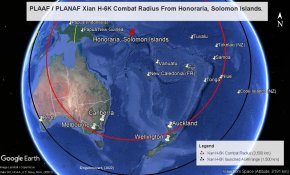Ngati, do you really think there is any chance that you will get T26? I would have thought something like a T31 is much more likely; maybe not that actual ship fit, I hope not anyway, but that sort of all up cost. I would love to see the RNZN with three T26, but just can’t see where that sort of political will is going to come from. I accept that many of your people might want an increase to defence, but your current crop of pollies doesn’t seem to (or even understand what is going on in the real world). And they are running the show. Without something to put the real frighteners on them I can’t see them changing their spots.
I hear scuttlebutt that the RNZN senior sirs want the T-26, but realistically I can't see that happening. However I have been very keen on the idea of the
Arrowhead 140 hull and machinery with the SPY-7, AEGIS, CEC etc., from the the
RCN CSC. Of course part of the CSC fitout isn't suitable for NZ but it would work. The AH140 is 7,000 tonnes displacement and if needs be say a 5m or 10m plug could be used to extend the hull length. Steel is cheap and air is free. The other thing I have been taking close note of is the
SH Defence CUBE Modular System which I think is ideal, especially because it uses the footprint of the 20ft ISO TEU (container).
As you rightly note, the pollies are the problem, but if there's a change of govt next November then the NZ National Party has an ex RNZN / RAN officer in it's top five who was a Collins Class XO or CO. Other National Party MPs are ex military as well and that cohort is fairly high in the Parliamentary wing of the Party. The other right wing Party, ACT has a very strong defence policy, which is unusual for them. They are wanting to start spending NZ$9.6 billion on defence per year from 2026. If they stick to that and get it through, that gives a CAPEX of say NZ$3.6 billion per year (in 2022 dollars) and if that's spent over 15 years, that will turn NZDF into a lean, mean, fighting machine. This is a Party that is allergic to government spending. If they get enough MPs into Parliament - either an electorate seat or 5% of the Party vote they will go into coalition with the National Party. However there's 11 months between now and the election and anything can happen in that time. I also don't trust pollies.
Post this on their twitter time line on a regur basis? Point out that the CCP knows where Parliament and the Beehive are.
Yes, maybe I should.

It was that crushing downwards push. Again China doesn't have to defeat every ship and plane in the western World, just those that are located near it. The Americans are split all over the world. The Europeans underfund their own defence capabilities and can't see past the Russian threat.
Australia and NZ aren't the main aims of Chinese war planners. The military have neither the taste for Waikato beer or a war like hunger for Cheese. But cutting off the straits would be a serious concern and threat to them.
Look at the history and strategy of the Pacific war during WW2 and have a look at a map of the region. Australia is an unsinkable aircraft carrier and base for an American pushback into PRC conquered areas if it's managed to annihilate Guam, and removed the Japanese and South Koreans from the war. The Japanese may possibly have three enemies to deal with - PRC, North Korea, and Russia. South Korea - North Korea and PRC. The Japanese and Russians still haven't solved their differences over the Japanese islands north of Japan, occupied by Russia, two of which Russia was supposed to have returned to Japan.
I am genuinely curious of what comes out of the NZ defence review.
We all are. But given the current govts track record with its organisational abilities, don't hold your breath.
Well 4 I think may be possible, in the realm, perhaps with a lighter fitout, it could be an overbuild OPV, that could take on additional systems etc. 3 It seems very doable. Even if things are rotated through crewing during peace time like Norway does it. But there are options, depending on what type of frigate, capabilities that are considered, money and crew available.
I think that the Norwegians aren't the best example. We would be better looking at the RDN - Royal Danish Navy because we have more in common with them.
There are many bad possibilities in our future. Collapsing US or China would be terrible.
Yes it would and given all the political shenanigans and divisiveness present in the US, one has to wonder about its future. Nightmarish.
However, I think Xi is most likely to make his 4th term. What I have said is basically what Kevin Rudd is currently telling anyone who will listen. The time to assert against Xi has passed when he made his 3rd term. There is now no challenge to him, and he will be leader until he dies, he has re-established the cult of the personality.
He has smashed the economic and political precedents set by his predecessors, says Australia’s former prime minister

www.economist.com
Kevin Rudd is now Australia's ambassador to the US. He wrote his PhD thesis on Xi. He heads up the largest Asian think tank in the west. He lived in china for over a decade and is familiar with Xi personally. He officially represents Australian policy.
I know about Rudd's credentials, however things can change and Xi has changed the PRC; not for the better. Unlike the time of Mao, Deng, and even Jiang Zemin, many of the PRC population have access to the internet and even though it's behind the Great Firewall, they can still generally find out what's happening and make their views known.
Depends what platform the RNZN and NZG end up settling on. Agree with regards both acquisition cost and crewing that even 3 x Type 26 will be a stretch.
If NZ opted for a highly automated platform such as the Mogami class it's conceivable that the ANZACs could be replaced on a 2 for 1 basis.
Considering the OPVs are due for replacement in 2032 ($600m - 1bn) and HMNZS Manawanui around 2035, perhaps a class of 6 could be considered. While not the gold plated solution, this approach would simplify logistics and training, delivering more capability than at present, with broadly similar crew numbers.
The trouble with multi-rolling is that you can do to much of it and it inhibits you rather than increasing your abilities. Do you really want a 7,000 tonne frigate undertaking a role that an OPV used to do? Maybe that's where a corvette comes in. At the same time you cannot expect a Gucci'd OPV to undertake the role of a frigate. It just doesn't work because they fill two completely different roles. A Gucci'd OPV or a corvette isn't going to survive a high end combat, but a corvette has a far better chance than a Gucci'd OPV, but not the same chance as a frigate. To use a racing term, it's horses for courses.
We actually have 2 FFHs, 4 IPVs and 2 OPVs to replace, plus 1 FFG because two are clearly not enough, so that's 9 hulls and those 9 hulls are a minimum. I would suggest a frigate / corvette combination with 3 FFG and a minimum of 6 corvettes. Because of our location and requirements, a generic Euro corvette isn't going to meet out requirements. We should remember the lessons of the Loch / Lake Class PBs and Protector Class IPVs and OPVS, none of which were / are suitable for NZ requirements. It's the basic hull that's the problem so something around 3,500 tonnes displacement is required. The hull used for the MEKO 200 frigates comes to mind because it's roomy enough and with a change of machinery, NZ stipulated fitout etc., it would be ideal.
If you have a frigate / corvette combination then there are many commonalties including weapons, sensors etc., but the most important one is the CMS. If you use the same CMS then that is a big problem sorted. Take it to the next step and use a modular mission system, and you have a system that's right across your fleet for mission modules. Any ship can become a minelayer, mine hunter, oil spill recovery, operate UUVs / USVs, have extra battery capacity, carry extra electricity generators, extra weapons and so on.
Thanks for the detailed answer Ngati.
I found this to be a very interesting point. Would you start here and then work else what you can do given budget constraints.
Regards,
Massive
I have been running a NZDF procurement spreadsheet for the last 8 years and look at it quite regularly. Each year the costs grow, not because of inflation but because of more NZDF capabilities requiring replacement and / or being lost. At present my costs are running with a CAPEX of $3.6 billion per annum for 15 years over and above the current NZDF annual budget allocation.



